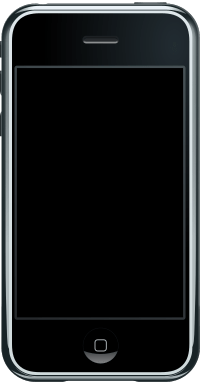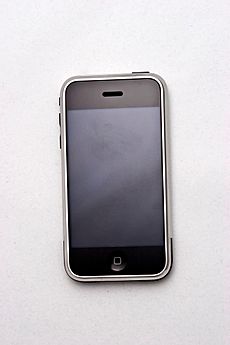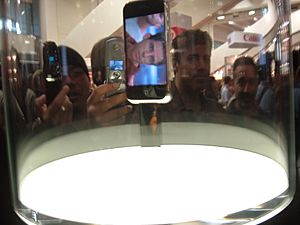- This page was last modified on 15 April 2025, at 02:15. Suggest an edit.
iPhone (1st generation) facts for kids
This page is about the first-generation iPhone. For the product line, see iPhone.
"iPhone 2G" redirects here. For the second-generation iPhone, see iPhone 3G.
 |
|

Front view
|
|
| Developer | Apple Inc. |
|---|---|
| Manufacturer | Foxconn (contract manufacturer) |
| Series | iPhone |
| First released | June 29, 2007 |
| Discontinued | July 15, 2008 |
| Units sold | 6,124,000 |
| Replacement model | iPhone 3G |
| Related | iPad, iPod Touch (comparison) |
| Type | Smartphone |
| Form factor | Slate |
| Size | 115 × 61 × 11.6 mm (4.53 × 2.40 × 0.46 in) |
| Weight | 135 g (4.8 oz) |
| Operating system |
|
| Memory | 128 MB eDRAM |
| Storage | 4, 8, or 16 GB flash memory |
| Battery | 3.7 V 1400 mAh Lithium-ion battery |
| Data inputs |
|
| Screen | |
| Rear camera | 2.0 MP with geotagging (not GPS-based) |
| Sound |
|
| Connectivity |
|
The iPhone (retroactively referred to as the iPhone 2G or iPhone 1) is the first iPhone model and the first smartphone developed and marketed by Apple Inc. After years of rumors and speculation, it was officially announced on January 9, 2007, and was released in the United States on June 29, 2007.
Development of the iPhone began in 2005 and continued in secrecy until its public unveiling at Macworld 2007. The device broke with prevailing mobile phone designs by eliminating most physical hardware buttons and eschewing a stylus for its finger-friendly touch interface. The iPhone instead featured only a few physical buttons and a touch screen. It featured quad-band GSM cellular connectivity with GPRS and EDGE support for data transfer, and it used continuous internet access and onboard processing to support features unrelated to voice communication. Its successor, the iPhone 3G, was announced on June 9, 2008.
The iPhone quickly became Apple's most successful product, with later generations propelling it to become one of the world's most profitable companies. The introduction of the App Store allowed established companies and startup developers to build careers and earn money, via the platform, while providing consumers with new ways to access information and connect with other people. The iPhone largely appealed to the general public, as opposed to the business community BlackBerry and IBM focused on at the time. By integrating existing technology and expanding on usability, the iPhone turned the smartphone industry "on its head".
Contents
History
In 2000, Apple CEO Steve Jobs envisioned an Apple touchscreen product that the user could interact with directly with their fingers rather than using a stylus. The stylus was a common tool for many existing touchscreen devices at the time including Apple's own Newton, launched in 1993. He decided that the device would require a triple layered capacitive multi-touch touch screen, a very new and advanced technology at the time. This helped with removing the physical keyboard and mouse. The same as was common at the time for tablet computers, human machine interfaces, and point of sale systems. Jobs recruited a group of Apple engineers to investigate the idea as a side project. When Jobs reviewed the prototype and its user interface, he saw the potential in developing the concept into a mobile phone to compete with already established brands in the then emerging market for touch screen phones. The whole effort was called Project Purple 2 and began in 2005. Apple purchased the "iphone.org" domain in December 1999.
Apple created the device during a secretive and unprecedented collaboration with Cingular Wireless, now part of AT&T. The development cost of the collaboration was estimated to have been $150 million over a thirty-month period. Apple rejected the "design by committee" approach that had yielded the Motorola ROKR E1, a largely unsuccessful collaboration with Motorola. Instead, Cingular Wireless gave Apple the liberty to develop the iPhone's hardware and software in-house. The original iPhone was introduced by Steve Jobs on January 9, 2007, in a keynote address at the Macworld Conference & Expo held in Moscone West in San Francisco, California. In his address, Jobs said, "This is a day that I have been looking forward to for two and a half years," and that "today, Apple is going to reinvent the phone". Jobs introduced the iPhone as a combination of three devices: a "widescreen iPod with touch controls"; a "revolutionary mobile phone"; and a "breakthrough Internet communicator."
Six weeks prior to the iPhone's release, the plastic screen was replaced with glass. This was after Jobs was upset when he saw that his keys scratched the prototype in his pocket. The quick switch led to a bidding process for a manufacturing contractor that was won by Foxconn, which had just opened up a new wing of its Shenzhen factory complex specifically for this bid.
Release
Six out of ten Americans surveyed said they knew before its release that the iPhone was coming. The iPhone was released in the United States on June 29, 2007, at the price of $499 for the 4 GB model and $599 for the 8 GB model, both requiring a 2-year contract. Thousands of people were reported to have waited outside Apple and AT&T retail stores days before the device's launch; many stores reported stock shortages within an hour of availability.
Sales to the European market started in November 2007, first in Germany, followed by Britain and then France. Reports suggested that these launches were met with less enthusiasm. In France it was sold by Orange for 649 euros. The iPhone was released in Austria and the Republic of Ireland on March 13, 2008.
In Canada, Rogers Wireless announced in April 2008 that a deal was reached with Apple to bring the iPhone to the Canadian market. The original iPhone was eventually not released in Canada in favor of the second-generation iPhone 3G.
Hardware
External hardware (screens, materials, etc)
The iPhone's back cover is made out of aluminum, a soft metal. The iPhone's screen is a 320×480-resolution LCD screen at 163 ppi that measures about 3.5 inches diagonally, much bigger than most other phones at the time, and the iPhone was the first mobile phone with multi-touch technology. The rear camera on the iPhone has a resolution of 2 megapixels and also features geotagging. The iPhone has four total buttons and a single switch: a power and sleep button, a volume up and volume down button, a silent/ringer switch, and a home button positioned in the bottom center of the face of the phone. The home button, when pressed, would send the user back to the home screen from whatever app they were currently using.
Internal hardware (motherboard, system-on-chip, etc.)
The iPhone features a Samsung 32-bit ARM microprocessor, underclocked from its stock 620 MHz to a slower 412 MHz to increase battery life. Its GPU is the PowerVR MBX Lite 3D.
The iPhone also includes several sets of sensors, including an accelerometer, a proximity sensor, and an ambient light sensor. Similar to the iPod Touch, the iPhone also features a 3.5 millimeter auxiliary headphone jack. The phone also has a 3.7 V 1400 mAh lithium-ion battery built in it.
Software
At the time of its unveiling in January, Steve Jobs claimed: "iPhone runs OS X" and runs "desktop-class applications", but at the time of the iPhone's release, the operating system was renamed "iPhone OS".
The original iPhone supported three major versions of the operating system before it was discontinued: iPhone OS 1, 2, and 3. The last update the original iPhone received was iPhone OS 3.1.3, as iPhone OS 3.2 was intended for the iPad.
Software history
The original operating system for the original iPhone, iPhone OS 1, featured Visual Voicemail, multi-touch gestures, HTML email, Apple's Safari web browser, threaded text messaging, an "iPod" music and video player app, a dedicated YouTube app and a Maps app powered by Google Maps. It also included basic Phone/contacts, Calendar, Photos, Stocks, Weather, Clock, Calculator, Notes, and Settings apps. However, many features like MMS, apps, and copy and paste were not supported at release, leading hackers to jailbreak their phones to add these features. Software updates from Apple gradually added these functions.
A v1.1 update alongside the introduction of the iPod Touch in September 2007 included an iTunes Store app that was the first new app to be added to the system.
iPhone OS 2 was released on July 11, 2008, at the same time as the release of the iPhone 3G, and introduced Apple's App Store supporting native third-party applications, Microsoft Exchange support, push e-mail, and other enhancements.
iPhone OS 3 was released on June 17, 2009, alongside the iPhone 3GS, and introduced a copy and paste functionality, Spotlight search for the home screen, and new features for the YouTube app. iPhone OS 3 was available for the original iPhone as well as the iPhone 3G and 3GS. However, not all features of iPhone OS 3 (such as MMS in the Messages app) were supported on the original iPhone.
iPhone OS 3.1.3 was the last version of iPhone OS (now iOS) to be released for the phone in February 2010, which never got the full iPhone OS 3 feature set because iPhone OS 3.2 was intended for the iPad.
Almost all apps released after the release of iOS 6 in late September 2012 do not run on the original iPhone, as the software development kit (SDK) was changed to no longer allow the "targeting" (minimum) of iOS versions older than 4.3 (including 3.x), or ARMv6 devices (first two generations).
See also
 In Spanish: IPhone (1.ª generación) para niños
In Spanish: IPhone (1.ª generación) para niños


